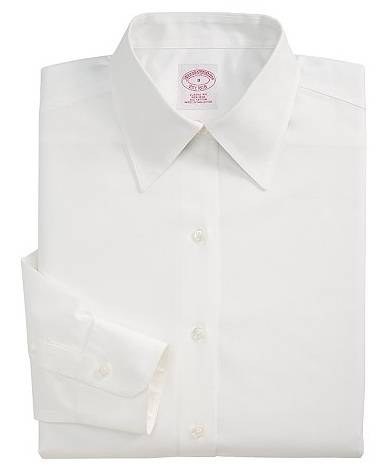
The Hidden Cost Behind Cheap White Dress Shirts
It is a shopper’s nature to pursue the best possible bargain, often sacrificing countless hours in the name of the hunt. As a youngster, I lost entire Saturday afternoons whenever my mother deemed it necessary to add to my “Sunday best” wardrobe, and dragged me through the city in search of a reasonably priced white dress shirt.
Today, it is a bargain hunter’s paradise. Low-priced clothing floods the market as companies continue to relocate offshore to lower production costs by taking advantage of cheap labour. The perceived need for inexpensive clothes, which fuels the supply, has kept the majority of the world’s female apparel workers enslaved. On the heels of International Women’s Day, we need to create awareness and accept responsibility not only for the air we breathe, the water we drink, but also for the clothes we wear.
It is no coincidence that manufacturers move to developing countries where wages are shockingly low. From an annual gross pay of USD$798 in Bangladesh to USD$ 2026 in China, it seems hard to believe that earnings are enough to support one person, much less an entire family. Surprisingly, workers in the European Union do not fare much better. At an annual gross income of USD$2152 in Bulgaria to USD$ 5101 in the Czech Republic, apparel and textile workers provide clothing brands with a low cost labour force and the right to say “Made in the European Union”.
Minimum Wage by Country (annual gross pay in U.S. Dollars)1
- Bangladesh $798.00
- Bulgaria $2152.00
- Cambodia $672.00
- China $2026.00
- Czech Rep. $5101.00
- Haiti $817.00
- Indonesia $1027.00
- Madagascar $981.00
- Mauritius $1737.00
- Mexico $1753.00
- Romania $3734.00
- Sierra Leone $211
- Sri Lanka $1619.00
- Turkey $5928.00
- Ukraine $2296.00
- Vietnam $1002.00

From a consumer’s perspective, the most shocking fact is that these offshore manufacturing practices are not exclusive to the low end of the market. Expensive designer brands are made in the same countries and, often times, in the same factories as mass produced, cheap clothing. When purchasing a costly designer garment, a significant portion of the price goes to subsidizing marketing and advertising to justify the brand and a shopper’s loyalty. If I were to walk into a reputable menswear store and select a designer shirt, which was made offshore, the approximate price tag of $245.00 would be broken down as follows: 17% ($41.65) of the total goes to marketing and advertising; 50% ($122.50) goes to the retail store; 25% ($61.25) goes to the designer; 4.5% ($11.03) goes to the factory that made the shirt; 3% ($7.35) is cloth; and 0.5% ($1.22) goes to the person who sewed the shirt.
Choosing to support brands that take advantage of workers impacts the Canadian economy. As it relates to apparel and textile manufacturing, exports, the GDP and employment decrease as companies take their production offshore. Between 2007 and 2008, shipments decreased 24% while the GDP dropped 22.5%.2 Although Canada lost a total of 322,000 manufacturing jobs, from 2004 to 2008, the clothing and textile sector experienced the most with almost half their jobs disappearing.3 By purchasing these brands, we are slowly killing our domestic apparel manufacturing industry, which creates thousands of jobs for Canadians, in addition to condoning the exploitation of textile workers around the globe.

The issue of fair labour practices within the fashion industry was at the centre of public attention in the 80’s and 90’s. Today, offshore manufacturing in developing countries has become the accepted norm. Becoming informed consumers is the simplest and most effective way to understand how we influence lives at home and across the globe with little more than our buying habits. In a way, shopping has redefined western democracy. With each purchase, a consumer casts a ballot for or against the status quo.
If you share my passion regarding this issue, then look before you buy. If a garment, or for that matter any product, is made in Canada, the USA or what was once known as Europe, then fair labour wages were used in its production. I realize that there will be a slight premium to be paid, in most cases up to 10%, but you are also getting much more value and quality for your money.
In our age of social consciousness, we must protect the essence of fair labour practices. Our politicians and leaders must lead by example by wearing Canadian made clothing and enacting legislation to make a difference on a local and global level. Let us send a clear message that Canadians refuse to exploit and enslave the world’s textile workers so that we can buy cheap white dress shirts.
References:
- Wikipedia, “List of Minimum Wages by Country”, http://en.wikipedia.org/wiki/List_of_minimum_wages_by_country, March 2012.
- Industry Canada, “Apparel Industry Profile”, http://www.ic.gc.ca/eic/site/026.nsf/eng/h_00070.html, Dec. 2011.
- Statistics Canada, Bernard, Andre, “Trends in Manufacturing Employment”, http://www.statcan.ca/pub/75-001-x/2009102/article/10788-eng.htm, Feb. 2009.













